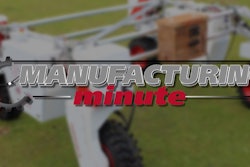Farming With A Robot
We all know Old McDonald had a pig and cow, but soon robots could be joining the farm. With a flexible frame, agricultural robot “Thorvald” is able to traverse uneven terrain and is agile enough to navigate between rows without touching plants. According to its creators at the University of Lincoln and the Norwegian University of Life Sciences, “Thorvald” was designed to be used in a variety of tasks including deployment as a multi-purpose light-weight carrying platform, as a sensor platform to monitor crops and soils and possibly precision weed control. The agricultural robot is currently operated by radio remote control, however the Lincoln team plans to outfit Thorvald with sensors and software to allow it to roam the fields autonomously. While doing this, it will use a Cosmic-ray Soil Moisture Observing System, or COSMOS, to keep track of soil moisture. Data collected from the robot’s trek through the fields would let farmers know which areas need water the most. Researchers say Thorvald is one of the key innovations of future farming. Potentially, Thorvald will be able to measure other factors of soil and crop quality allowing farmers to increase the precision of their agriculture systems. Additional tools would also allow the robot to assist in other tasks such as seeding, weeding and spraying.
SO, WHAT DO YOU THINK?
How do you see this type of technology being applied outside of agriculture? Let us know what you think in the comments below.
Advances In Robotic Motion
Wearable robotic exoskeletons could revolutionize the way factories operate by assisting human workers in lifting heavy loads or performing tasks more efficiently.
But such exoskeletons are already in use in medicine, and a team of researchers from China and Denmark recently announced a dramatic advance in those robots' capabilities.
Their prototype exoskeleton, like others, can fit around a patient's lower limbs to assist with rehabilitating the human gait. Unlike others, however, the mechanism slides and rotates in order to mimic the complex natural movements of the knee joint. Engineers believe the system could dramatically improve robot-assisted therapy and training -- helping stroke or spinal cord injury victims resume walking more quickly. They hope to test it with doctors and hospitals before spiffing up its appearance and commercializing it. The team also believes that the technology could eventually be used to develop a bionic knee joint.
SO, WHAT DO YOU THINK?
Could a better robotic exoskeleton help factory workers in addition to physical therapy patients? Let us know your thoughts in the comments below.






















